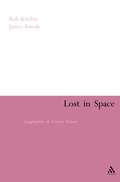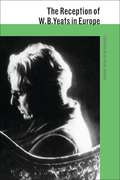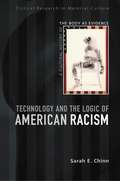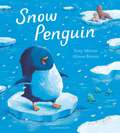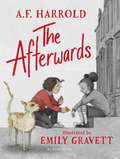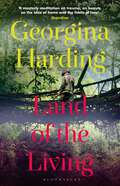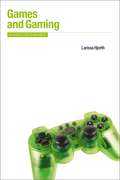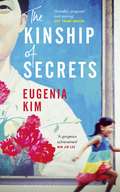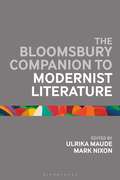- Table View
- List View
Shakespeare for all Secondary: An Account Of The Rsa Shakespeare In Schools Project
by Maurice GilmourAn account of the RSA Shakespeare in Schools project, which demonstrates that Shakespeare can be made accessible to students of all abilities from the age of 5 upwards. The book provides accounts of performances of Shakespeare plays at a number of secondary schools, and includes illustrated explorations of topics ranging from language to villains. It links the use of Shakespeare to the National Curriculum, emphasizing the fact that Shakespeare can be fun, even for very young students. The book has a companion Primary level volume.
The Reception of James Joyce in Europe (The Reception of British and Irish Authors in Europe)
by Geert Lernout Wim Van MierloJames Joyce is now widely considered the most influential writer of the twentieth century. His name and his most important works appeared again and again in fin-de-millennium surveys. This is the case not only in the English-speaking world, but also in many European literatures. Joyce's influence is most pronounced in French, German and Italian literatures, where translations of most of his works appeared during his life-time and where he had a clear impact on his fellow-writers. In other countries and cultures, his influence took more time to register, sometimes after the war in the fifties and sixties, and sometimes only in the final decade of the century. This was the case in most of the languages of Eastern Europe, where the translation of Joyce's work could only begin after the collapse of the Soviet Union in the 1990s.This book contains two volumes.Series Editor: Dr Elinor Shaffer FBA, Institute of Germanic & Romance Studies, School of Advanced Study, University of London Contributors to the volume include: Sonja Basic (University of Zagreb) Eric Bulson, (Columbia University) Astradur Eysteinsson (University of Reykjavik) Kalina Filipova (University of Sofia) Marta Goldmann (University of Budapest) Jakob Greve (University of Copenhagen) Manana Khergiani (New York) Teresa Iribarren (University of Barcelona) Onno R. Kosters and Ron Hoffman (The Netherlands) Alberto Lázaro (University of Alcalá, Madrid) Marisol Morales Ladrón (University of Alcalá, Madrid) Maria Filomena Louro (University of Minho, Portugal) Tina Mahkota (University of Ljubljana) John McCourt (University of Trieste) Patrick O'Neill (Queen's University, Canada) Adrian Otoiu (North University of Baia Mare, Rumania) Miltos Pehlivanos (Aristotle University, Greece) Aleš Pogacnik (Slovenia) Jina Politi (Aristotle University, Greece) Steen Klitgård Povlsen (University of Aarhus) H.K.Riikonen (University of Helsinki) Frank Sewell (University of Ulster) Sam Slote (University of Buffalo) Per Svenson (Sweden) Emily Tall (University of Buffalo) Björn Tysdahl (University of Oslo) Tomo Virk (University of Ljubljana) Jolanta W. Wawrzycka (Radford University) Robert Weninger (Oxford Brookes University) Wolfgang Wicht (University of Potsdam) Serenella Zanotti (University of Rome)
The Reception of Ossian in Europe (The Reception of British and Irish Authors in Europe)
by Howard GaskillJames Macpherson's Poems of Ossian, said to be translations from the Gaelic of a third-century bard, caused a sensation on their first appearance in the early 1760s. Contrary to the impression often conveyed in literary histories, enthusiasm for the poetry of the 'Homer of the North' cannot be dismissed as a short-lived fad, for its appeal lasted a century or more, both at home and abroad. There is hardly a major Romantic poet on whom it failed to make a significant impact. In the words of Sir Walter Scott, it succeeded in "giving a new tone ot poetry throughout all Europe" and its influence was ubiquitous, from Poland to Portugal, from Paris to Prague. The essays brought together here consider the reception of Ossian in England, Scotland, Wales and Ireland, as well as in a wide range of European countries. In some the focus is on individual writers (for instance, Goethe, Schiller, Chateaubriand, Espronceda), in others there is a broader sweep and a survey of reception in a national literary culture is offered (for instance, Hungary, Russia, Sweden). One of the two essays on Ossian in Italy at last gives Macpherson's influential epigone, John Smith, his due. Consideration is also given to Ossian's significance for the rise of historicism, and to non-literary forms of reception in music and art. Series Editor: Dr Elinor Shaffer FBA, Institute of Germanic & Romance Studies, School of Advanced Study, University of London   Contributors: Howard Gaskill, University of Edinburgh Dafydd Moore, University of PlymouthDonald Meek, University of EdinburghMary-Ann Constantine, University of WalesMícheál Mac Craith, University of GalwayJoep Leerssen, University of AmsterdamColin Smethurst, University of GlasgowSandro Jung, University of Wales, LampeterCaitríona Ó Dochartaigh, Dublin Institute for Advanced StudiesWolf Gerhard Schmidt, University of SaarbrückenPeter Graves, University of SwedenJames Porter, University of AberdeenGabriella Hartvig, University of PécsNina Taylor-Terlecka, Oxford, UKPeter France, University of Edinburgh Enrico MattiodaFrancesca Broggi-WüthrichAndrew GingerGerald Bär, Aberta UniversityChristopher Smith, Norwich, UKMurdo MacDonald, University of DundeeReception of Ossian in Europe Review Reception of Ossian in Europe Review 2
London Narratives: Post-War Fiction and the City (Continuum Literary Studies)
by Lawrence PhillipsThe post-war redevelopment of London has been the most extensive in its history, and has been accompanied by a dramatic social and cultural upheaval. This book explores the literary re-imagining of the city in post-war fiction and argues that the image, history, and narrative of the city has been transformed alongside the physical rebuilding and repositioning of the capital. Drawing on the ideas of Michel de Certeau, Henri Lefebvre, Anthony Vigler and others as well as the latest work on urban representation, this book is an important contribution to the study of the intersection between place, lived experience, and the literary imagination. Texts covered include novels by some of the most significant and lesser known authors of the period, including Graham Greene, George Orwell, J. G. Ballard, Stella Gibbons, David Lodge, Doris Lessing, B. S. Johnson, Sam Selvon, V. S. Naipaul, Peter Ackroyd and Iain Sinclair.
The Reception of Virginia Woolf in Europe (The Reception of British and Irish Authors in Europe)
by Mary Ann Caws Nicola LuckhurstThe intellectual scope and cultural impact of British writers cannot be assessed without reference to their European fortunes. These essays, prepared by an international team of scholars, critics and translators, record the ways in which Virginia Woolf has been translated, evaluated and emulated in different national and linguistic areas of Europe. Diverse as her reception has been, as analyst of consciousness, as a decadent (censored and banned), as stylistic innovator of Modernism, as crusading feminist and socialist, and as a model for other writers, she has emerged as one of the foremost writers and principal icons of the century.
The Reception of Laurence Sterne in Europe (The Reception of British and Irish Authors in Europe)
by Peter De Voogd John NeubauerThe intellectual scope and cultural impact of British writers in Europe cannot be assessed without reference to their 'European' fortunes. This collection of 14 essays, prepared by an international team of scholars, critics and translators, records how Sterne's work has been received, translated and imitated in most European countries with great success. Among the topics discussed in this volume are questions arising from the serial nature of much of Sterne's writings and the various ways in which translators across Europe coped with the specific problems that the witty and ingenious Sternean text poses.
Index of English Literary Manuscripts: Volume 3, Part 2, John Gay-Ambrose Philips
by Margaret M. SmithEleven authors are included in this final part of Volume III of the Index, beginning with Laurence Sterne andconcluding with Edward Young. It also includes the final cumulative first-line index of all the verse which isdescribed in the manuscript entries or mentioned in the Introductions in Parts 1-4 of Volume III.
Postcolonial Con-Texts: Writing Back to the Canon (Literature, Culture, and Identity)
by John ThiemeIn recent years works such as Jean Rhys's Wide Sargasso Sea, J.M. Coetzee's Foe and Peter Carey's Jack Maggs, which 'write back' to classic English texts, have attracted considerable attention as offering a paradigm for the relationship between post-colonial writing and the 'canon'. Thieme's study provides a broad overview of such writing, focusing both on responses to texts that have frequently been associated with the colonial project or the construction of 'race' (The Tempest, Robinson Crusoe, Heart of Darkness and Othello) and texts where the interaction between culture and imperialism is slightly less overt (Great Expectations, Jane Eyre and Wuthering Heights). The post-colonial con-texts examined are located within their particular social and cultural backgrounds with emphasis on the different forms their responses to their pre-texts take and the extent to which they create their own discursive space. Using Edward Said's models of filiative relationships and affiliative identifications, the book argues that 'writing back' is seldom adversarial, rather that it operates along a continuum between complicity and oppositionality that dismantles hierarchical positioning. It also suggests that post-colonial appropriations of canonical pre-texts frequently generate re-readings of their 'originals'. It concludes by considering the implications of this argument for discussions of identity politics and literary genealogies more generally. Authors examined include Chinua Achebe, Margaret Atwood, Kamau Brathwaite, Peter Carey, J.M. Coetzee, Robertson Davies, Wilson Harris, Elizabeth Jolley, Robert Kroetsch, George Lamming, Margaret Laurence, Pauline Melville, V.S. Naipaul, Caryl Phillips, Ngugi wa Thiong'o, Jean Rhys, Salman Rushdie, Djanet Sears, Sam Selvon, Olive Senior, Jane Urquhart and Derek Walcott.
The Reception of Jonathan Swift in Europe (The Reception of British and Irish Authors in Europe)
by Hermann J. RealJonathan Swift has had a profound impact on almost all the national literatures of Continental Europe. The celebrated author of acknowledged masterpieces like A Tale of a Tub (1704), Gulliver's Travels (1726), and A Modest Proposal (1729), the Dean of St Patrick's, Dublin, was courted by innumerable translators, adaptors, and retellers, admired and challenged by shoals of critics, and creatively imitated by both novelists and playwrights, not only in Central Europe (Germany and Switzerland) but also in its northern (Denmark and Sweden) and southern (Italy, Spain, and Portugal) outposts, as well as its eastern (Poland and Russia, Hungary, Romania, and Bulgaria) and Western parts - from the beginning of the eighteenth century to the present day.
Lost in Space: Geographies of Science Fiction
by Rob Kitchin James KnealeScience fiction - one of the most popular literary, cinematic and televisual genres - has received increasing academic attention in recent years. For many theorists science fiction opens up a space in which the here-and-now can be made strange or remade; where virtual reality and cyborg are no longer gimmicks or predictions, but new spaces and subjects.Lost in space brings together an international collection of authors to explore the diverse geographies of spaceexploring imagination, nature, scale, geopolitics, modernity, time, identity, the body, power relations and the representation of space. The essays explore the writings of a broad selection of writers, including J.G.Ballard, Frank Herbert, Marge Piercy, Kim Stanley Robinson, Mary Shelley and Neal Stephenson, and films from Bladerunner to Dark City, The Fly, The Invisible Man and Metropolis.
Shakespeare's Books: A Dictionary of Shakespeare Sources (Continuum Shakespeare Dictionaries)
by Stuart GillespieThis encyclopedia-style Dictionary is a comprehensive reference guide to Shakespeare's literary knowledge and recent scholarship on it. Nearly 200 entries cover the full range of literary writing Shakespeare was acquainted with, and which influenced his own work, including classical, historical, religious and contemporary works. It provides an overview of his use of authors such as Virgil, Chaucer, Erasmus, Marlowe and Samuel Daniel, whose influence is across the canon. Other entries cover anonymous or collective works such as the Bible, Emblems, Homilies, Chronicle History plays and the Morality tradition in drama. Entries cover writers and works whose importance to Shakespeare has emerged more clearly in recent years due to new research. Others describe and explain current thinking on long-recognized sources such as Plutarch, Ovid, Holinshed, Ariosto and Montaigne. Entries for all major sources, over 80 in number, feature surveys of the writer's place in Shakespeare's time, detailed dicussion of the relationship to Shakespeare's plays and poems, and full bibliography. Sample passages from writers and texts of early modern England allow the volume to be used also as a reader in the literature commonly known in Shakespeare's era; these excerpts, together with reproductions of pages and illustrations from the original texts, convey the flavor of the material as Shakespeare would have encountered it.
The Reception of W. B. Yeats in Europe (The Reception of British and Irish Authors in Europe)
by Klaus Peter JochumThe intellectual and cultural impact of British and Irish writers cannot be assessed without reference to their reception in European countries. These essays, prepared by an international team of scholars, critics and translators, record the ways in which W. B. Yeats has been translated, evaluated and emulated in different national and linguistic areas of continental Europe. There is a remarkable split between the often politicized reception in Eastern European countries but also Spain on the one hand, and the more sober scholarly response in Western Europe on the other. Yeats's Irishness and the pre-eminence of his lyrical work have posed continuous challenges. Three further essays describe the widely divergent reactions to Yeats in his native Ireland, during his lifetime and up to the most recent years.
Technology and the Logic of American Racism: A Cultural History of the Body as Evidence (Critical Research in Material Culture)
by Sarah E. ChinnIn this book, Sarah E. Chinn pulls together what seems to be opposite discourses--the information-driven languages of law and medicine and the subjective logics of racism--to examine how racial identity has been constructed in the United States over the past century. She examines a range of primary social case studies such as the American Red Cross' lamentable decision to segregate the blood of black and white donors during World War II, and its ramifications for American culture, and more recent examples that reveal the racist nature of criminology, such as the recent trial of O.J. Simpson. Among several key American literary texts, she looks at Mark Twain's Pudd'nhead Wilson, a novel whose plot turns on issues of racial identity and which was written at a time when scientific and popular interest in evidence of the body, such as fingerprinting, was at a peak.
Costuming Cosplay: Dressing the Imagination (Dress, Body, Culture)
by Therèsa M. WingeCosplay, short for "costume play", has grown from its origins at fan conventions into a billion-dollar global dress phenomenon. Costuming Cosplay takes us from elaborately crafted DIY costumes to online fandoms, examining how the practice of portraying fictional characters from popular culture through dress and performance has become a creative means of expressing and playing with different identities.With an approach that ranges from admiration and role-play to gender performance, this is the first book to fully examine the subculture and costume of the Cosplay phenomenon. Drawing on extensive first-hand research at conventions across North America and Asia, Therèsa M. Winge invites us to explore how Cosplay functions as a meritocracy of creativity, escapism, and disguise, and offers a creative realm in which fantasy and new forms of socializing carry as much importance as costume.Illustrated with color photographs of both celebrity and amateur Cosplayers, Costuming Cosplay is essential reading for students and scholars of fashion and costume, popular culture, anthropology, gender, and media studies, as well as global players and fans of Cosplay.
Snow Penguin
by Tony Mitton Alison BrownIn the frozen Antarctic, one curious little penguin decides to explore the ice and the snow and the sea. On his travels he sees two blue whales, a family of sea lions and a whole school of orca, but soon Penguin starts to miss his own family. Sometimes coming home is the best adventure of all.Told in rhyming couplets, this feel-good book is perfect for bedtimes and cuddle-up times. From bestselling author Tony Mitton, and beautifully illustrated by Alison Brown.
Only the Ocean
by Natasha CarthewBreath-takingly fierce, smart and tender, Only the Ocean is a story of survival, and courage in the midst of darkness that will thrill fans of Patrick Ness and Sarah CrossanThe two girls sat at opposite ends of the boat and Kel dug and stretched the oars into the ocean like her life depended upon it because it did. 'Just so you know,' said Rose, 'everything, and I mean everything, is your fault.'Kel Crow lives in a dead-end swamp with her deadbeat family and a damaged heart. But she has a plan to escape. It's a one-two-three fortune story that goes: stow away on the ship, kidnap the girl, swap the girl to pay for passage to America and a life-saving operation.But the ocean is an untameable force, and wrecks ships and plans alike …Sweet, raw and uncompromising – this is the story of an unforgettable relationship forged on an epic journey.
The Afterwards
by A. F. Harrold Emily GravettFact: Ember and Ness are best friends. There's nothing more to say about it. It is what it is. It is what will always be. Ember and Ness.Then Ness dies. It is sudden and unexpected and leaves Ember completely empty. How can this be?When Ember finds a way into the Afterworld, she determines to bring Ness back. Because that's what friends do isn't it? They rescue each other. They help. They never give up. Ember and Ness. That don't change.A powerful, poignant, darkly comic and deeply moving story about friendship at its most extraordinary.
Land of the Living
by Georgina HardingA profound masterpiece on war, loss and survival, rendered in prose of rhythmic precision, subtlety and exceptional sensitivity, by the Orange Prize-shortlisted author of Painter of Silence'Arresting and brutal … the finely tuned work of a writer exceptionally at ease with her craft and a testament to the power and poetry of clean and disciplined prose' Sadie Jones, GuardianCharlie's experiences at the Battle of Kohima and the months he spent lost in the remote jungles of Assam during the Second World War are now history. Home and settled on a farm in Norfolk and newly married to Claire, he is one of the lucky survivors. Starting a family and working the land seem the best things a man can be doing. But a chasm exists between them. Memories flood Charlie's mind; at night, on rain-slicked roads and misty mornings in the fields, the past can feel more real than the present. What should be said and what left unsaid? Is it possible to find connection and forge a new life in the wake of unfathomable horror? A beautifully conceived, deftly controlled and delicately wrought meditation on the isolating impact of war and the inescapable reach of the past, Georgina Harding's haunting and lyrical novel questions the very nature of survival, and what it is that the living owe the dead.
Sports Day: A Bloomsbury Young Reader (Bloomsbury Young Readers)
by Jane Lawes Sarah JenningsEmmie's school is having a big sports day and everyone has to choose an event to take part in. There are running races, long jump, an egg-and-spoon race, and even the three-legged race. But Emmie isn't sure what to choose and she is sure that she is going to come in last...This fun and sporty adventure from author Jane Lawes is perfect for children who are learning to read by themselves and for Key Stage 1. It features engaging illustrations by Sarah Jennings and relatable characters young readers will find hard to resist.Bloomsbury Young Readers are the perfect way to get children reading, with book-banded stories by brilliant authors like Julia Donaldson. They are packed with gorgeous colour illustrations and include inside cover notes to help adults reading with children, as well as ideas for activities related to the stories.Book Band: WhiteIdeal for ages 6+
Zoom to the Moon: A Bloomsbury Young Reader (Bloomsbury Young Readers)
by Jenny McLachlan Andy RowlandOn a school trip to the space museum, Reva and Bobby climb into a real rocket named Jupiter Two. The poor rocket has never been into space so when Reva and Bobby count down and press a big red button, Jupiter Two bursts into life. Soon Reva and Bobby are on their way to the moon!This extraordinary and imaginative adventure from well-loved author Jenny McLachlan is perfect for children who are learning to read by themselves and for Key Stage 1. It features engaging illustrations from Andy Rowland and quirky characters young readers will find hard to resist. Bloomsbury Young Readers are the perfect way to get children reading, with book-banded stories by brilliant authors like Julia Donaldson. They are packed with gorgeous colour illustrations and include inside cover notes to help adults reading with children, as well as ideas for activities related to the stories.Book Band: LimeIdeal for ages 6+
The Kinship of Secrets
by Eugenia KimThe riveting story of two sisters, one raised in the United States, the other in South Korea, and the family that bound them together even as the Korean War kept them apart'A gorgeous achievement' Min Jin Lee, author of Pachinko'Graceful, poignant and moving' Viet Thanh Nguyen, Pulitzer Prize-winning author of The SympathizerIn 1948 Najin and Calvin Cho, with their young daughter Miran, travel from South Korea to the United States in search of new opportunities. Wary of the challenges ahead, Najin and Calvin make the difficult decision to leave their other daughter, Inja, behind with their extended family; soon, they hope, they will return to her. But then war breaks out in Korea, and there is no end in sight to the separation. Miran grows up in prosperous American suburbia, under the shadow of the daughter left behind, as Inja grapples in her war-torn land with ties to a family she doesn't remember. Najin and Calvin desperately seek a reunion with Inja, but are the bonds of love strong enough to reconnect their family over distance, time and war? And as deep family secrets are revealed, will everything they long for be upended? Told through the alternating perspectives of the distanced sisters, and inspired by a true story, The Kinship of Secrets explores the cruelty of war, the power of hope, and what it means to be a sister.
The Bloomsbury Companion to Modernist Literature (Bloomsbury Companions)
by Ulrika Maude Mark NixonIn this book, leading international scholars explore the major ideas and debates that have made the study of modernist literature one of the most vibrant areas of literary studies today. The Bloomsbury Companion to Modernist Literature offers a comprehensive guide to current research in the field, covering topics including: · The modernist everyday: emotion, myth, geographies and language scepticism · Modernist literature and the arts: music, the visual arts, cinema and popular culture· Textual and archival approaches: manuscripts, genetic criticism and modernist magazines· Modernist literature and science: sexology, neurology, psychology, technology and the theory of relativity· The geopolitics of modernism: globalization, politics and economics· Resources: keywords and an annotated bibliography
Piers Plowman: Concordance
by Joseph WittigThis is a complete Concordance to the A, B and C texts of Piers Plowman in the Athlone Press editions. Each word in the vocabulary of the three versions (approximately 5,400) is listed alphabetically in its order of occurrence within the particular version, in the succession A, B, C. Except for a few words of extremely frequent occurrence such as the definite and indefinite articles, common conjunctions and the personal pronouns (all these are indexed) each occurrence of each word is listed within its line of context. Words of similar spelling are, where called for, lexicographically distinguished, as are parts of speech. A system of cross-reference to a headword allows for the variety of spelling and dialect forms, and those forms and their frequency are given after the headword. The Latin and French elements in the three texts are concorded in Appendices. The Concordance will prove to be an indispensable tool for the study of the content, language and style of Langland's poems.
Family Fictions (Contemporary Classics in Children's Literature)
by Nikki Gamble Nick TuckerFamily Fictions provides an introduction to the history of family stories in children's literature and an in-depth critical study of the works of Jacqueline Wilson, Anne Fine and Morris Gleitzman.
The Piers Plowman Glossary: Will's Visions Of Piers Plowman, Do-well, Do-better And Do-best : A Glossary Of The English Vocabulary Of The A, B, And C Versions As Presented In The Athlone Editions
by George KaneThis Glossary is designed as a companion to William Langland's dream vision poem, Piers Plowman, widely regarded as the greatest literary work in Middle English before Chaucer. It glosses and explains over 5000 English words, and foreign words used as if English, in the A, B and C texts of Piers Plowman printed in the critically-acclaimed Athlone editions. Where possible, it illustrates words with examples from all three versions.The first glossary to Piers Plowman was compiled in 1886 by Sir William Skeat but there has been no attempt, until now, to provide a new glossary that takes account of the considerable advances in Middle English scholarship over the last century. This new Glossary gives particular attention to the distinctive problems inherent in its subject, how the texts were preserved, written and received in their time. It takes account of the dialectical and morphological variations between the three texts; the grammar of Langland's style; the richly figurative texture of the rhetorical language used in the poem; and the remoteness of many elements in its content from modern culture and its values.









